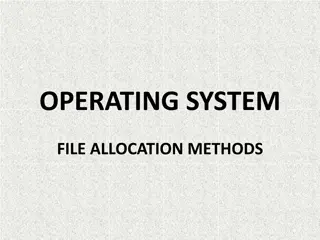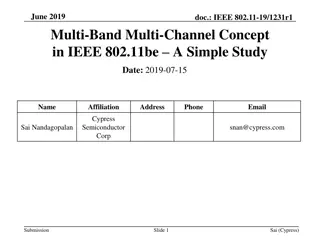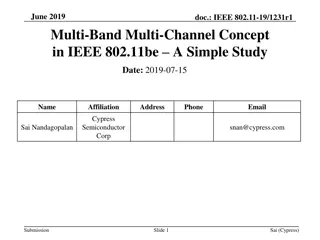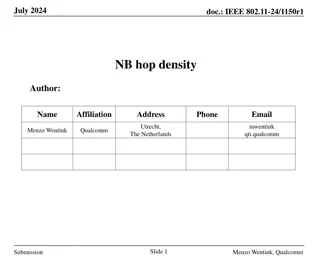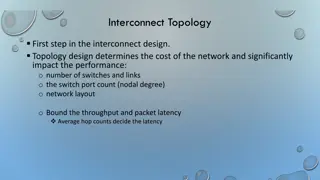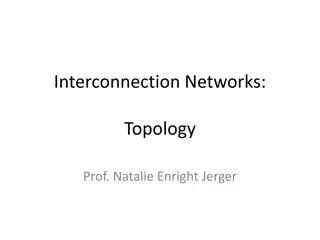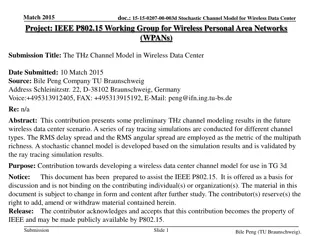Research on Channel allocation in Multi-hop Network
This research delves into the critical issue of channel allocation in multi-hop networks, exploring distributed and centralized methods for efficient spectrum utilization and interference management. Various existing approaches are reviewed, highlighting challenges and potential solutions in this complex networking scenario.
Uploaded on Feb 17, 2025 | 0 Views
Download Presentation

Please find below an Image/Link to download the presentation.
The content on the website is provided AS IS for your information and personal use only. It may not be sold, licensed, or shared on other websites without obtaining consent from the author.If you encounter any issues during the download, it is possible that the publisher has removed the file from their server.
You are allowed to download the files provided on this website for personal or commercial use, subject to the condition that they are used lawfully. All files are the property of their respective owners.
The content on the website is provided AS IS for your information and personal use only. It may not be sold, licensed, or shared on other websites without obtaining consent from the author.
E N D
Presentation Transcript
Research on Channel allocation in Multi-hop Network Weixu Zhuang, Xinbing Wang Department of Electronic Engineering Shanghai Jiao Tong University, China
Outline Introduction Introduction Background Related work Contributions System Model and Problem Formulation System Model and Problem Formulation Simulation Results Simulation Results Conclusions Conclusions 2 2
Background Multi-hop network has been studied a lot since it is the only feasible mean of communication in some environment such as large sensor network. It is really close to reality since in large space, source nodes are always far away from their destination. In multi-hop network, if selfish nodes arbitrarily access the channel, serious interference problem will be caused. As a result, an efficient method to efficiently allocate the channel is needed to help all nodes in the network use the channel wisely and let most data arrive its destination. Spectrum is reusable among bidders subjecting to the spatial, interference constraints. Because interference is only a local effect. Nodes close to each other cannot use the same spectrum frequency simultaneously but well-separated bidders can. 3
Background There are two different methods to solve this channel allocation problem in multi-hop network A distributed algorithm without a central node. A centralize method with a central node to allocate the channel wisely. 4
Background The centralize method: It may be more efficient than the distributed method if the central node has all the information of the network and nodes in the network can have simple application in their hands. The central node has difficulty in collect the true information of all nodes in the network. The distributed method: It can save a lot of overhead because it doesn t need a central node. It may suffer a relatively low efficiency and each node in the network have to equip some application with the computation ability because they must make sure the decision they make will help they to get more benefit 5
Related work Xia Zhou, Sorabh Gandhi in [3] proposed an truthful auction framework to allocate the channel to nodes in the network which allowed spectrum reuse among well-separated nodes. It just discusses the problem in single-hop network. Bo-Ruei Kao, Liang-Ku Lee in [1] discusses the problem of channel allocation in multi-hop network using auction. It doesn t propose a truthful auction to solve the problem which means the auction in its paper cannot avoid manipulation of bidders in the network. Jain et al. [4] has proved that the channel allocation problem in multi- hop network is an NP-hard problem. It doesn t give out efficient methods to solve it. [3] Xia Zhou, Sorabh Gandhi, Subhash Suri and Haitao Zheng. eBay in the Sky: Strategy-Proof Wireless Spectrum Auctions, In IEEE Mobicom, San Francisco, California, USA, Sep. 2008. [4]Jain, K., Padhye, J., Padmanabhan, V. N., and Qiu, L. Impact of interference on multi-hop wireless network performance, In Proc. of MobiCom, San Diego, CA, USA, Sep. 2003. [1] Bo-Ruei Kao, Liang-Ku Lee, Lai, K.R. Multi-hop Auction-Based Bandwidth Allocation in Wireless Ad Hoc Networks, In Advanced Information Networking and Applications(AINA), pp. 772 - 778, Mar. 2011. 6
Contributions We propose an auction in the multi-hop network which can ensure the truthfulness. We introduce a mechanism for the auctioneer(or owner of the spectrum) which can not only ensure the revenue of the network but also consider the fairness among nodes in our multi-hop network. We introduce some algorithms to efficiently allocate the channel. Then, by comparing the performance of the algorithms, we can figure out which algorithm perform best in our network in different circumstances. 7
Outline Introduction Introduction System Model and Problem Formulation System Model and Problem Formulation System Model Problem Formulation Simulation Results Simulation Results Conclusions Conclusions 8
System Model = We have a set of nodes in the network. Besides, all nodes want to transmit their data to the central node. In addition, nodes laying far away can reuse the channel. When a node use the channel to transmit data, other receiving nodes lay in the interference zone of this node cannot use the channel simultaneously. 1, , N n An example of the network scenario with a central node and several transmission nodes. We have only one channel in the network 9
System Model Basic Assumption for Model Every node in the network knows the routing to the destination which means they know whom they should transmit data to. We call a transit node and a receiving node as a data-link. Every data link has its own interference zoom and the auctioneer knows the interference relation among these data-links. Finally, we let the transit node to represent the data-link as a bidder in the auction. ic 10
Problem formulation Key notations ----The bid of node i for the channel ib ip ----The price auctioneer charges node i for using channel ----The true value of node i for the channel iv iw ----The weight of vertex i or node i ---- The buffer length of node i il 11
Problem formulation The definition of some notations The weight of bidder i = w b l i i i ip We charge the winner i of the auction the boundary bid which means if i bids higher than , he can win the auction, otherwise, he will lose. w p l w ip = m i i is the highest weight belonging to a node which lays in the interference zone of i. m 12
Problem formulation The auctioneer uses some algorithms(such as greedy algorithm or linear programming) to allocate the channel. We charge the node i who uses the channel iy w l w is the highest weight belonging to a node which lays in the interference zone of i but do not interfere with the other nodes which are selected to use the channel n = n y i i Then, the auctioneer redistribute these revenue of the network by allocate the revenue of the winners of our auction. = R y i D = (d1, d2...) denotes the winners of the auction 13
Problem formulation The algorithm we use to select to winners of the auction 14
Problem formulation Main Theorem 15
Problem formulation Then, we present our solutions to efficiently allocate the channel, given the location of every node and the weight of every node. The channel allocation problem can be converted to a weighted vertex cover problem. The algorithms include LP algorithm, N-LP algorithm and greedy algorithm. We will introduce the algorithms and compare the results of these algorithms. 16
Outline Introduction Introduction System Model and Problem Formulation System Model and Problem Formulation Simulation Simulation Results Results Conclusions Conclusions 20 20
Comparison of Algorithms The comparison of the total weight of chosen nodes in one time slot among the three different algorithms 21 21
Comparison of Algorithms The network throughput in three thousand time slots 22 22
Comparison of Algorithms The buffer status of nodes in the network 23 23
Outline Introduction Introduction System Model and Problem Formulation System Model and Problem Formulation Simulation Simulation Results Results Conclusions and Future work Conclusions and Future work 24 24
Conclusions In our paper, we develop a new kind of auction called VARYVER to discuss the channel allocation problem in multi-hop network. The mechanism of this VARYVER action not only ensure the truthfulness of every bidders bids but also consider the fairness among nodes in our network. In addition, we introduce several algorithms to help auctioneer to efficiently solve the channel allocation problem. By comparing the behaviors of these algorithms in simulation results, we find that Greedy Algorithm is better to get a high throughput of the network, while LP Algorithm is a better choice when we consider both the throughput and the fairness among cognitive nodes of the network. 25 25
















